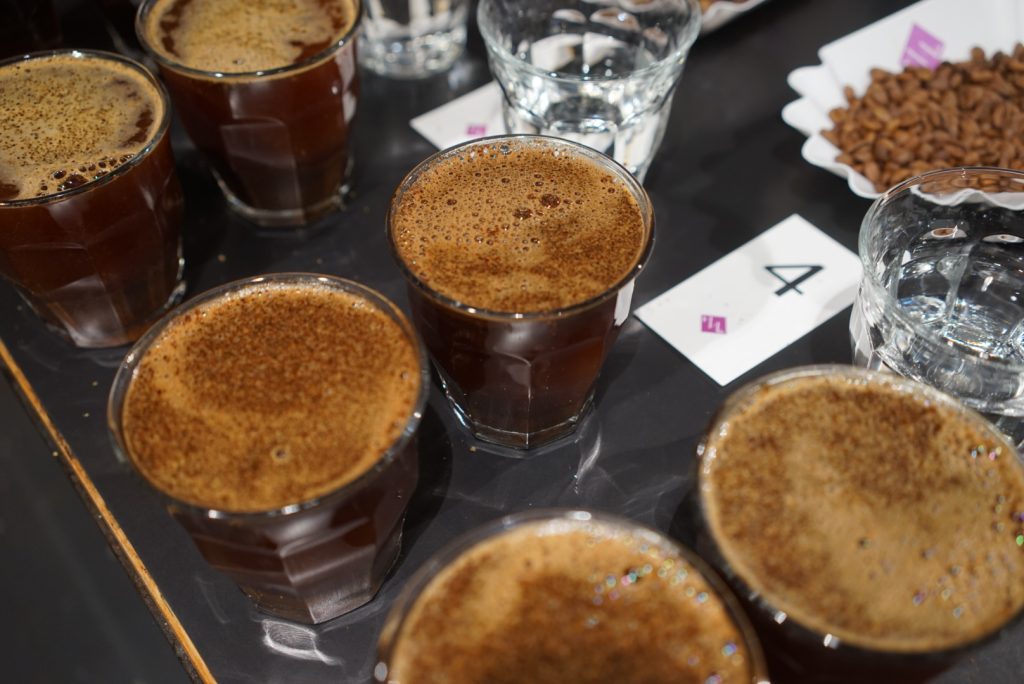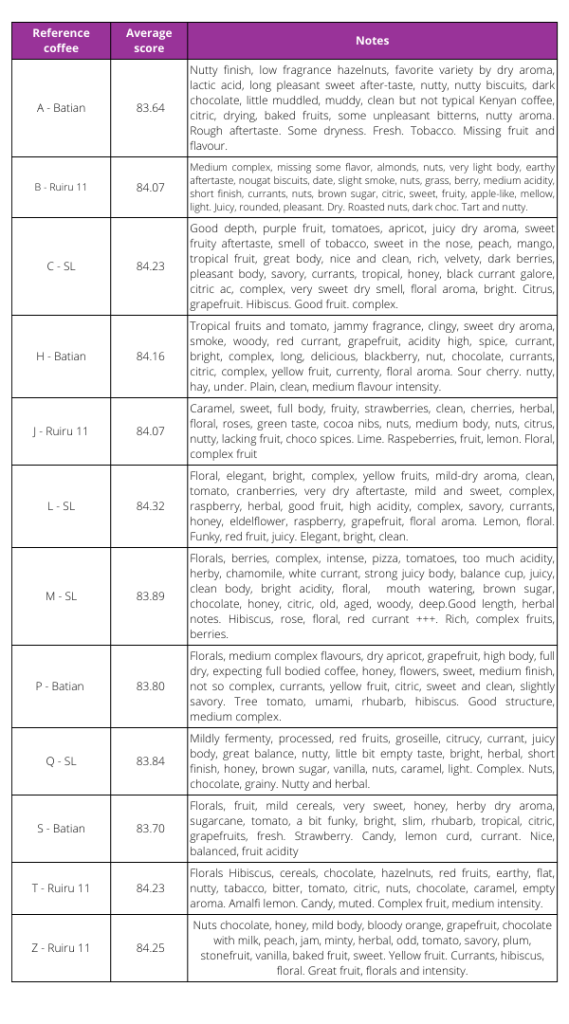In April 2022, Nordic Approach organized a blind cupping for over 45 participants who shared their thoughts with us on 12 coffees of different varieties: SL Varieties, Ruiru 11 and Batian.
This was part of a research that our Kenyan partners C. Dorman Ltd. have been conducting for over 6 years “COFFEE VARIETIES CUPPING PROJECT” in which they seek to create a solid base of information on the quality and performance of the different coffee varieties that are grown in the African country.
The setting for this blind cupping was rather informal, and we do not consider it to be a source of truth. But even so, we found the results very interesting and unexpected. The highest score was an SL coffee followed by a Ruiru 11, while Batian seemed to be the least attractive.
Our input provided Dormans with more data and information to back up the very valuable research, which has given us a better understanding of what people think of the different Kenyan varieties.

An overview of the Coffee varieties Cupping Project
Considering this initiative is valuable for producers, farmers, the country as a whole, and roasters who buy Kenyan coffee, we spoke to Kennedy Keya, Trading and Operations Director of C. Dorman Ltd. about its goals and findings for this year.
Kennedy has worked for C. Dorman since 1993. He started as an assistant in the shipping department and later became the shipping manager. In 2007, he moved to the trading desk as a trading assistant and was later confirmed as a trader in 2010. He has been working in the company for almost thirty years.
Can you provide us with some context to understand the reason behind this project?
The varieties that were established in the early 1900s were the SL: SL28 and SL34, and these have been the traditional varieties for many years. As things progressed, researchers came along and wanted to develop a variety that could adapt to climate change, be high-yielding, require less agricultural inputs, etc. So, in 1985 farmers were introduced to a new variety called Ruiru 11.
The problem was that people who were used to the old variety were a bit apprehensive and hesitant with Ruiru 11, as they said it lacked some of the Kenyan characteristics of black currant notes and some juiciness.
Nevertheless, Ruiru 11 is a high-yielding plant, which means that it requires fewer farm inputs (fewer fungicides and fertilizers). Also, it’s more resistant to Coffeeberry Disease, which is very common when it gets cold in the month of July.
One of the largest challenges the coffee plant faces is the fungus that causes CBD or “Coffee Berry Disease.” The fungus lives in the bark of the coffee tree and produces spores which attack the coffee cherries and become dark, almost black in color and if it spreads at a farm or estate it can be devastating. It can be treated with copper formulations or organic fungicides. Still, this is too expensive for most farmers.
Farmers say Ruiru 11 can resist all, so that’s why they were moving from the traditional variety of SL28 and SL34 to Ruiru 11, but on the quality side, there were some doubts. If you ask farmers, they are more interested in getting high yields to get more money.
So, many farmers started growing Ruiru 11, a trend that continued until another new variety was developed: Batian. Researchers say that Batian would bring some of the lost characteristics of the SL varieties, and would still be high yielding like Ruiru 11.
Tell us about the variety Cupping project and why it was developed
People like me focus more on quality and that’s why we started this project.
On a demonstration plot, we have planted the three varieties: Ruiru 11, Batian and SL.
So all are growing under very similar climatic conditions. Flowering happens at the same time and picking happens at the same time. The difference is that we pick them separately, process them separately and cup them separately in blind cuppings
That’s the project goal. To see whether there will be a difference in quality. Having all three varieties growing under the same conditions should give you certain results which maybe resemble. But if one is much lower, it means that what critics are saying could be true.
It’s an exercise that helps us get feedback from those who participate in the cupping to see if there are differences in quality due to the different varieties.
What led to the appearance of the other new varieties?
Life is always changing. The climate is changing, and farmers want more yield and to use fewer farm inputs. In Kenya, there is a coffee research station that conducts studies to have better coffee seedlings.
This is not just in Kenya, I think it is all over the world. It’s science, and people want to keep improving the varieties to make sure that the crop is secure for the future.
Why did you decide to develop this project?
Over the years, some buyers who used to buy coffee in the 1980s or 1990s have said that Kenyan quality is going down. And what can we point to as a reason for this? We can point to things like climate change, but mostly, we can point to things like variety change.
So this kind of project is just to measure the differences in quality due to the different varieties. The answer remains open to people who cupped all these varieties to tell us if they have perceived maybe less intensity in flavour or more acidity, etc.
There is one thing that cannot be doubted. The new varieties, especially Ruiru 11, are high yielding, and for many farmers, this means more money in their pockets, which may matter to them more than any other factor.
At the moment, we may not have the strength to put pressure on decision-makers to insist on a certain variety, but at least, we can have a point or a platform to argue on when some of these discussions or questions come up: which variety produces the best quality? Or, what’s the problem with the latest interventions?
So, it’s creating a basis for discussion with facts, because it is not very wise to start just criticizing something when you cannot prove it. That’s why we need the opinion of as many people as possible in a very objective way, without being influenced by our personal thinking or our personal taste.
We want something that can give farmers the best quality in Kenya, but at the same time also good yields.
What impact will this have on farmers?
At the moment, the results will not influence farmers, because if it comes to deciding on new varieties, this happens more at the governmental level. It is the government that sets up the seedlings and what variety to plant.
What we ultimately want to do is that, in case they open up and want to discuss quality issues, we have something to show them.
Why is it important to include roasters in the blind cuppings?
Roasters are the foundation of our business. Without the roasters, we are not in business, and we must give them what they want. Also, we want to hear from them and learn how they perceive these different varieties.
Of all the three varieties, which one is your favourite?
Personally, I’m still from the old school. Quality-wise, I believe SL28 and SL34 are the best, but on the other hand, I agree it has low yield and is susceptible to getting attacks of CBD, among other diseases, and that requires a lot of farm inputs. So it’s tricky in that sense. Nevertheless, from a quality standpoint, I think it still keeps Kenya at the top.
Last but not least: can you send a message to all the roasters that are reading this post?
I want to reiterate that Kenyan coffee continues to be the best coffee. We will continue to do our part to identify the best coffees that you like. Furthermore, we will not let you down in that regard. We will continue to select the best of the best for your market.
The rest, of course, keeps changing, and it’s not in our control when it comes to the prices of coffees every year, but our part in getting the best quality will continue to do so.
Results
Each participant of the blind cupping rated sweetness, acidity, flavour, aftertaste and overall (personal preference) of each coffee with a score between 0 and 10.
| Sweetness 1-10 | Acidity 1-10 | Flavor 1-10 | Aftertaste 1-10 | Overall 1 – 10 | Summary (0-50) points |
The scores of each participant were summed to obtained the average score.
Take a look at these interesting results:
The letters preceding the variety were only used to maintain anonymity in the blind tasting.
We would like to thank Kennedy for the interview and all the information he shared with us.
